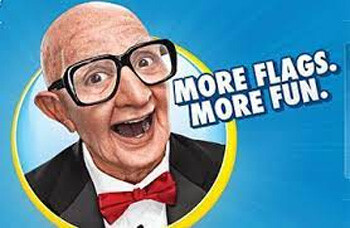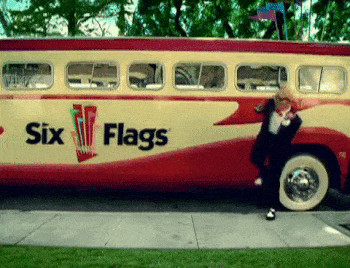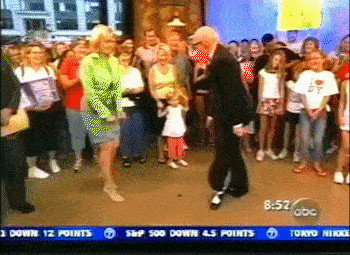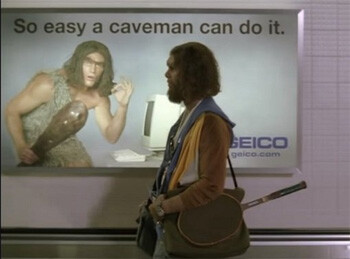Advertising agencies have a unique talent for tapping into the collective consciousness, sometimes in ways that are profoundly unsettling. They can conjure up imagery and characters that burrow into our brains, for better or worse, and in the early 2000s, few advertising creations were as effectively (and arguably horrifyingly) memorable as Mr. Six, the dancing mascot for Six Flags theme parks. This tuxedo-clad, seemingly geriatric figure, with his frenetic dance moves and ubiquitous presence, became a cultural phenomenon, sparking reactions ranging from amusement to outright revulsion. Love him or hate him, Mr. Six left an indelible mark on the advertising landscape and the minds of anyone who witnessed his energetic performances.
 the six flags mascot mr. sixSix Flags
the six flags mascot mr. sixSix Flags
Mr. Six was more than just an advertising mascot; he was an experience. Encountering him on television was akin to a cultural meltdown – a shared, slightly traumatic experience for a generation. His image is seared into the collective memory, a bizarre yet captivating figure forever associated with the Six Flags brand. While the desire for vengeance against his creators might be a humorous exaggeration, the intensity of the reaction he provoked is undeniable. Let’s delve into the strange story of Mr. Six, exploring his origins, his rapid rise to fame, and the reasons behind his equally swift disappearance.
The Genesis of a Marketing Monster
The story of Mr. Six begins, unsurprisingly, in the creative rooms of an advertising agency. In the early 2000s, Doner Advertising was tasked with revitalizing the image of Six Flags. In a moment that perhaps advertising historians may one day pinpoint as a turning point (for better or worse), the concept of Mr. Six was born. It wasn’t the result of meticulous planning or focus group testing, but rather, as legend has it, a somewhat chaotic brainstorming session.
Imagine a room filled with advertising executives, throwing out ideas – some good, many questionable. Someone suggests, “What if we had… a dancing guy?” In the world of advertising, simple ideas can sometimes be the most impactful, and this seemingly basic concept gained traction. Then, in a move that cemented Mr. Six’s peculiar nature, another voice chimed in, “And what if he’s old? Like, an old guy dancing? That’s unexpected, maybe even funny.” This seemingly off-the-wall suggestion somehow resonated, and the core concept of Mr. Six, the elderly dancing mascot, began to solidify.
 the six flags mascot mr. sixSix Flags
the six flags mascot mr. sixSix Flags
The idea evolved further. To achieve the necessary energy for the dance routines, the character would be portrayed by a younger, more agile performer, disguised with makeup and prosthetics to appear older. This decision added another layer of surrealism to the character. And finally, to complete the bizarre package, the soundtrack was chosen: the relentlessly catchy, if somewhat grating, “We Like to Party!” by the Vengaboys. The combination of these elements – the elderly dancer, the energetic moves, the upbeat but slightly annoying song – created a character that was undeniably attention-grabbing, if not entirely pleasant.
 Six Flags Mr Six adSix Flags
Six Flags Mr Six adSix Flags
The stage was set. Mr. Six was no ordinary mascot; he was a carefully constructed, slightly unsettling concoction designed to break through the advertising noise and capture the public’s attention, even if it meant venturing into the realm of the bizarre.
Unleashing the Dancing Demon on Television
In 2004, the Mr. Six advertising campaign was unleashed upon television screens across America. The commercials typically followed a simple, yet effective formula. They would depict ordinary, perhaps slightly bored, families going about their day in suburban settings. Suddenly, a bus would arrive, and out would step Mr. Six. Dressed in his signature tuxedo and glasses, he would begin his energetic, somewhat jerky dance routine to the instrumental version of “We Like to Party.”
The reactions of the families in the commercials were initially a mix of confusion and apprehension, perfectly mirroring the likely reactions of viewers at home. However, they quickly became captivated, drawn in by Mr. Six’s infectious (if slightly manic) energy. Invariably, they would hop on the bus, presumably heading to the nearest Six Flags park for a day of fun.
The commercials were undeniably effective. Mr. Six was instantly memorable, and the “We Like to Party!” theme song became inextricably linked with the Six Flags brand. Whether viewers found him endearing, annoying, or somewhere in between, they were talking about Mr. Six. And in the world of advertising, getting people to talk is often half the battle.
The second commercial followed a similar pattern, reinforcing the image of Mr. Six as a disruptive, yet ultimately enticing, force. He would appear in unexpected places, dance his signature moves, and convince unsuspecting families to join him on a trip to Six Flags. The repetition and ubiquity of the commercials ensured that Mr. Six became a constant presence in the media landscape.
Mr. Six Mania: A Cultural Moment
The Mr. Six campaign was a resounding success. The character became a cultural phenomenon, permeating popular culture in a way that few advertising mascots ever achieve. Six Flags fully embraced the character, dubbing him the “Ambassador of Fun” and plastering his image throughout their theme parks. Mr. Six was everywhere – on billboards, in park signage, and even in live appearances within the parks themselves.
His popularity reached such heights that he even made an appearance on Good Morning America, a sure sign that a character has truly broken into the mainstream. This appearance, while further cementing his fame, also perhaps signaled the beginning of the character’s saturation point. When something reaches Good Morning America, it’s often a sign that it’s become a ubiquitous, and potentially overexposed, part of the cultural landscape.
 Diane Sawyer and Mr Six dancing on good morning americaABC
Diane Sawyer and Mr Six dancing on good morning americaABC
Six Flags even capitalized on the Mr. Six craze by hosting a Mr. Six look-alike contest at one of their parks. The fact that hundreds of people showed up to mimic the bizarre dance moves and appearance of Mr. Six is a testament to the character’s widespread recognition and impact. It was a moment of peak Mr. Six mania, highlighting just how deeply the character had infiltrated the public consciousness.
However, as with many viral sensations, the intense popularity of Mr. Six was relatively short-lived. The character burned brightly, but quickly.
The Swift Demise of the Ambassador of Fun
Just as quickly as he had risen to prominence, Mr. Six began to fade from the scene. In 2005, Dan Snyder, known for his controversial ownership of the Washington Commanders NFL team (then the Redskins), acquired Six Flags. One of his first actions as the new owner was to retire the Mr. Six character.
This decision, while perhaps surprising given Mr. Six’s initial success, was likely driven by a desire to rebrand and move away from the somewhat polarizing mascot. While Mr. Six was undeniably memorable, he also generated a significant amount of negative reactions. His appearance was often described as creepy or unsettling, and the relentless repetition of the commercials could become grating for some viewers.
 the geico caveman in an adGeico
the geico caveman in an adGeico
In a way, even a figure as controversial as Dan Snyder recognizing the need to remove Mr. Six speaks volumes about the character’s ultimate shelf life. It was a bold move, but one that signaled a shift in Six Flags’ marketing strategy. Mr. Six, the dancing ambassador of fun, was out.
For years, the identity of the person behind the Mr. Six mask remained a secret. It was eventually revealed that Danny Teeson, a professional choreographer and dancer, was the man responsible for bringing Mr. Six to life. He had been bound by a non-disclosure agreement, but eventually came forward to share his experience portraying the iconic character.
The Enduring Legacy of Mr. Six
Despite his relatively short reign, Mr. Six remains a significant figure in advertising history. He represents a case study in viral marketing, demonstrating how a bizarre and slightly off-putting character can capture the public’s attention and become a cultural touchstone.
Mr. Six’s legacy is complex. He was undeniably effective in raising brand awareness for Six Flags, but he also became a symbol of advertising excess and, for some, a figure of unintentional horror. His reappearance briefly a few years after his initial retirement was met with a largely indifferent, if not negative, response, proving that his time had truly passed.
Ultimately, Mr. Six serves as a reminder of the power of advertising to create lasting impressions, even when those impressions are tinged with the bizarre and slightly unsettling. He was a product of his time, a reflection of the early 2000s advertising landscape, and a testament to the enduring power of a catchy tune and a truly unforgettable (for better or worse) dancing guy.

